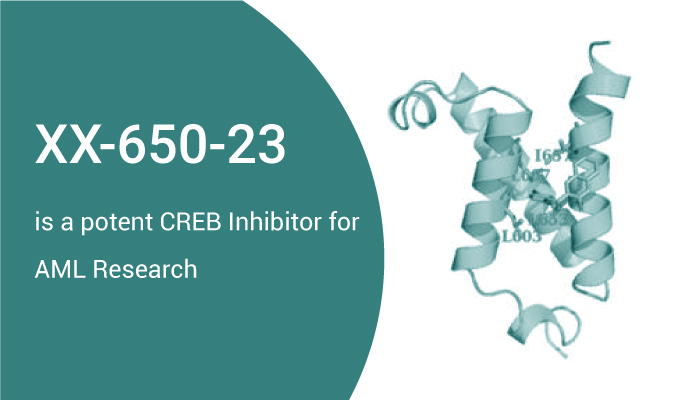Acute Myeloid Leukemia (AML) is a disease of the bone marrow, a disorder of hematopoietic stem cells due to genetic alterations in blood cell precursors resulting in overproduction of neoplastic clonal myeloid stem cells. Although AML remains a rare malignancy, accounting for only 1.2% of all new cancer diagnoses in the United States per year, it accounts for close to one third of all leukemias diagnosed. However, AML is associated with a 5-year overall survival of less than 50% despite the use of intensive chemotherapy regimens and hematopoietic stem cell transplantation. According to existing research data that the transcription factor CREB (cAMP Response-Element Binding Protein) is a critical regulator of the growth and survival of AML cells. Morover, elevated CREB expression was observed in ~60% of AML patients. Hence, we will introduce XX-650-23, a CREB inhibitor.
XX-650-23 is a potent CREB inhibitor.

XX-650-23 can disrupt the CBP-CREB interaction in AML cells and elicits an array of on-target transcriptional alterations, which leads to cell cycle arrest and apoptosis of AML cells.
In vitro, XX-650-23 (870 nM-2.3 μM; 48 hours) inhibits AML cell growth, the IC50 values are 870 nM, 910 nM, 2.0 μM and 2.3 μM for HL-60, KG-1, MOLM-13, and MV-4-11, respectively. In addition, XX-650-23 ( 5 μM; 6 or 24 hours) causes a specific decrease in H3K27 acetylation and is not a general inhibitor of acetyltransferase activity. Moreover, XX-650-23 (2 μM; 72 hours) elicits apoptosis through the intrinsic apoptosis pathway, with activation of caspase-3 and detectable caspase-9 cleavage. It also leads to the downregulation of Mcl-1 and bcl-2.
Besides, XX-650-23 significantly increases survival of cell lineand patient-derived xenograft mice with no toxicity to normal hematopoietic cells or animals.
All in all, XX-650-23 is a promising CREB inhibitor for research of AML.
Reference:
[1] Mitton B, et al. Leukemia. 2016 Dec;30(12):2302-2311.
[2] Pelcovits A, et al. R I Med J (2013). 2020 Apr 1;103(3):38-40.